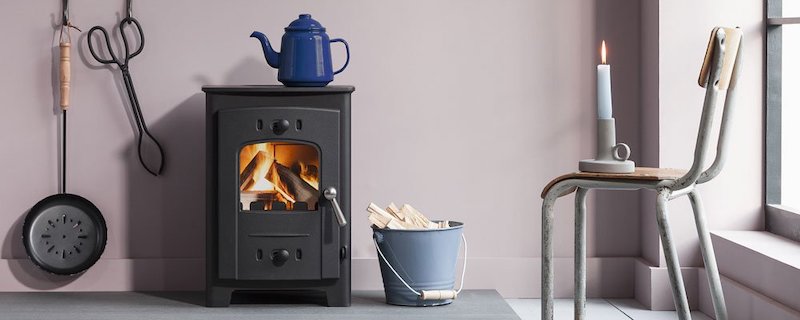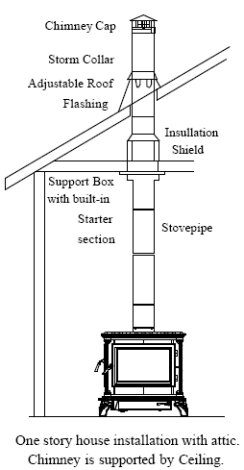It’s a common idea that you need to install a chimney before installing a wood burning stove. Find out Can You Install A Wood Burning Stove Without A Chimney?
A wood burning stove is a standalone unit that burns wood to generate heat. It typically has a metal firebox surrounded by a casing of brick, stone, or another non-combustible material. A wood burning stove can be an efficient and cost-effective way to heat your home, but it must be properly installed and vented to avoid safety hazards.
While you can install a wood burning stove without a chimney, you first have to understand what a chimney is to know why you can do without it. A chimney is a structure that is used to vent out the smoke and other hot gasses that form when one burns fuel such as wood. They are usually made of masonry material such as stones or bricks. They have an open space inside called a flue which allows smoke to travel from the hearth to the outside atmosphere.
Chimneys were extensively used in traditional houses as this was the only structure which could be used to effectively vent gas out of the home. With the advent of new materials to be used as vents, chimneys have become less of a necessity for stoves and instead have become aesthetic features for the home.
Can You Install A Wood Burning Stove Without A Chimney?
If you’re considering a wood burning stove for your home, you might be wondering if you can install one without a chimney. The answer is yes, you can install a wood burning stove without a chimney, but there are a few things you need to know first.
First of all, it’s important to note that not all stoves are created equal. If you’re going to be installing a wood burning stove without a chimney, you’ll need to make sure that the stove is designed for this type of installation. Some stoves are better suited for installation without a chimney than others.
Once you’ve found the right stove, the next step is to install it properly. This means following the instructions carefully and making sure that all of the necessary parts are in place before lighting the fire. If everything is installed correctly, your wood burning stove should work just as well without a chimney as it would with one.
Of course, there are some drawbacks to installing a wood burning stove without a chimney. One of the biggest is that you won’t be able to take advantage of the natural draft that a chimney provides. This means that your stove will have to work harder to draw air into the firebox and could potentially lead to less efficiency.
Another potential issue is that smoke and other pollutants can build up inside your home more quickly without a way to escape through a chimney. If you live in an area with high air pollution,
How to Install a Wood Burning Stove Without A Chimney?
If you’re considering a wood burning stove for your home but don’t have a chimney, you may be wondering if it’s still possible to install one. The good news is that you can install a wood burning stove without a chimney, but there are a few things you need to take into consideration first.
The most important thing to consider when installing a wood burning stove without a chimney is ventilation. You need to make sure that the room you’re installing the stove in has adequate ventilation so that fumes and smoke can escape. This can be accomplished by opening windows or installing an exhaust fan.
Another thing to keep in mind is the clearance from combustible materials. Wood burning stoves generate a lot of heat, so you need to make sure that any nearby walls or furniture are at least 3 feet away from the stove.
Finally, you’ll also need to choose the right size stove for the space. If the room is too small, the stove will overheat and may pose a fire hazard. Conversely, if the room is too large, the stove won’t generate enough heat to be effective.
If you take these factors into consideration, you can successfully install a wood burning stove without a chimney.
Advantages and Disadvantages of Installing a Wood Burning Stove Without A Chimney
If you are considering installing a wood burning stove in your home, you may be wondering if you can do so without a chimney. While it is possible to install a wood burning stove without a chimney, there are both advantages and disadvantages to doing so.
One of the biggest advantages of installing a wood burning stove without a chimney is that it can save you money on installation costs. If you do not have to install a new chimney, you will not have to pay for the materials or labor associated with doing so.
Another advantage of installing a wood burning stove without a chimney is that it can be easier to do. If you do not have to worry about installing a new chimney, you may find that the installation process is simpler and quicker. This can be especially helpful if you are working with a limited budget or timeline.
There are some disadvantages to installing a wood burning stove without a chimney as well. One of the biggest disadvantages is that it can be more difficult to ventilate your home properly. Without a chimney, smoke and other fumes from your wood burning stove can build up inside your home, which can be dangerous. Additionally, without proper ventilation, your home may not heat evenly, which can lead to hot spots and cold spots.
You Just Need A Stove Pipe
A chimney isn’t a necessity when using a wood stove, so you don’t have to worry about building one if you haven’t got it in your house already. But you do need a flue or vent pipe which connects to your stove pipe. A flue can be made of different materials, but mostly it is made of a kind of steel with insulation. The flue or vent pretty much functions the same way as a chimney except that you can run it outside your home with very minimal construction.
So while a chimney isn’t a necessity, it is still important to have a conduit for the gas to escape through. This pipe should clear the roof and be of a minimum height to safely get rid of exhaust gases. They may be cleaned in the same way as chimneys to get rid of soot and creosote which can block gas and even cause accidental fires.
Some Tips About Venting Your Wood Stove
- Allow the Stove to Vent – the stove will produce smoke so it is necessary to have it vent to the outside to get rid of the smoke. This again does not mean you have to build a chimney. But you do have to run a conduit from the stove and out of your house to get rid of the smoke and gasses that a wood fire produces.
- Check proper clearance heights – vents will get rid of the smoke but it still needs to be high enough to cause less pollution. Smoke or gases rise out the vents since these are at a hotter temperature. When the pipe or smoke itself becomes cool, it will start to fall. If the pipe isn’t high enough, the smoke can cause pollution.
- Get a Professional – a certified installer will help you choose the right size, height and type of pipe. This will ensure your stove will function properly and keep you and your home safe. Check with the local building inspector as well to know that you are following local regulations.
Conclusion
This information should help you make a better choice in the installation of your stove. You may not need a chimney but you still do need to meet a lot of requirements. Installing a wood burning stove without a chimney is definitely possible, but there are some things you need to take into consideration before you do so.
Make sure that your chosen location for the stove is well-ventilated and that the flue pipe goes through an outside wall. You also need to be aware of the potential fire hazards involved with having a wood burning stove in your home, so make sure you take all the necessary precautions. I hope you like reading on Can You Install A Wood Burning Stove Without A Chimney?


